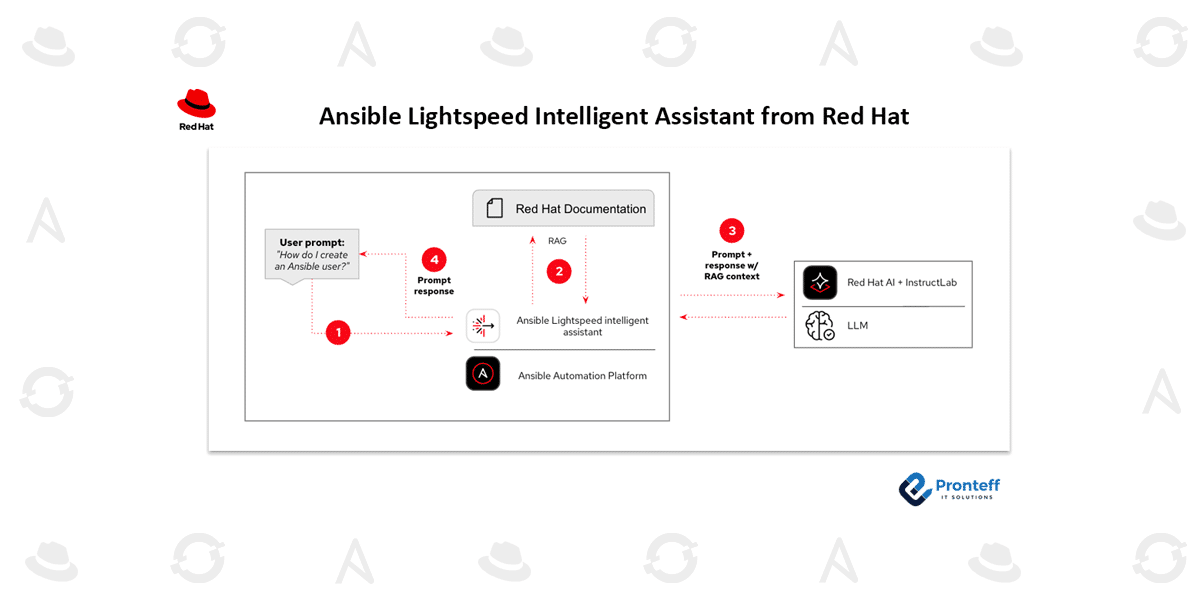Ansible Lightspeed Intelligent Assistant from Red Hat
In this blog, we will learn about the Ansible Lightspeed Intelligent Assistant from Red Hat.
We’re excited to officially announce the release of the Red Hat Ansible Lightspeed intelligent assistant, a generative AI–powered chat assistant seamlessly integrated into the Ansible Automation Platform. This intelligent assistant acts as an on-demand Ansible expert right at your fingertips—designed to streamline automation management, simplify troubleshooting, and accelerate onboarding.
The new assistant brings Red Hat documentation and knowledge directly into the Ansible user interface, allowing administrators and operators to find answers, explore guidance, and resolve issues without leaving the platform.
Enhancing the Ansible Automation Experience with Generative AI
This release represents a major milestone in our ongoing effort to deliver a more cohesive and intuitive user experience for automation administrators and IT operators. Alongside the intelligent assistant, we’ve introduced:
- A unified, simplified interface
- Self-service automation capabilities for wider accessibility
- A new on-premises analytics dashboard for performance monitoring
- Additional Ansible Collections for streamlined platform management
Extending Generative AI Capabilities in Ansible
When we first introduced Red Hat Ansible Lightspeed with IBM WatsonX Code Assistant in 2023, it was designed as a powerful AI-driven coding companion that accelerated the development of playbooks, roles, and tasks. Built on IBM’s Granite code models and trained with Ansible-specific data, the service helped developers write more efficient automation code while providing transparency and context through features such as:
- Content explanation and source matching
- Prompt refinement and custom model tuning for accuracy and relevance
Now, with the Ansible Lightspeed intelligent assistant, we’re extending those same benefits to administrators and operators—helping them research, diagnose, and solve issues directly within the platform.
What You Can Ask the Assistant
The assistant can answer a variety of operational and administrative questions, such as:
- What is an execution environment?
- How can I control or manage user permissions within the Ansible Automation Platform?
- Explain the ‘ERROR! couldn’t resolve module/action’ message.
- How do I configure Event-Driven Ansible?
Using a retrieval-augmented generation (RAG) pipeline connected to official Red Hat documentation and other resources, the assistant also provides verified reference links for further exploration.
Future Roadmap and Capabilities
Our future roadmap includes expanding data connectivity to provide deeper insights into automation health and performance. You’ll soon be able to use prompts like:
- Why did my automation job ‘VM-migration’ fail?
- Show all inventories included in my deployment.
- What is the progress or current state of all active jobs?”
Getting Started
Unlike the Ansible Lightspeed coding assistant, available exclusively with IBM WatsonX Code Assistant, the intelligent assistant supports multiple model options, including Red Hat AI platforms, with plans to integrate third-party general-purpose models in upcoming releases.
To enable the Ansible Lightspeed intelligent assistant, you’ll need:
- An active Ansible Automation Platform 2.5 subscription running on Red Hat OpenShift Container Platform (via the Ansible Lightspeed Operator)
- A large language model (LLM) deployed on a Red Hat AI platform or a compatible bring-your-own model setup
For detailed installation and configuration steps, refer to the official Red Hat documentation.








